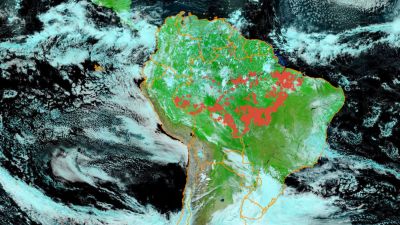This website uses cookies so that we can provide you with the best user experience possible. Cookie information is stored in your browser and performs functions such as recognising you when you return to our website and helping our team to understand which sections of the website you find most interesting and useful.

Satellite images of Brazil's Amazon rainforest in June show thousands of fires raging as dry season approaches, with conservationists warning that the region could be on track for a repeat of last year’s devastating blazes.
Brazil’s government space research agency, INPE, detected 2,248 fires in the Amazon rainforest last month, a 20 per cent increase from the 1,880 fires in June 2019. It was the worst June for fires in more than a decade, according to government data.
Health experts also expressed concern that smoke from the fires could lead to respiratory problems in the population and complicate tackling Brazil's vast number of coronavirus cases. More than 60,000 people have died of Covid-19 in Brazil and 1.4million have been infected, the World Health Organisation reported.
Anna Jones, Greenpeace UK Head of Forests, said: “These fires are no accident. Brazil’s President, Jair Bolsonaro, has done nothing to discourage ranchers and land grabbers to stop deforesting the Amazon. Despite the Covid-19 pandemic, deforestation has soared and now we are seeing fires deliberately lit to clear that land for industrial agriculture.
“This is just the beginning. Over the next few months, unless we see strong intervention, fires will be likely to increase and engulf vast areas of forest, endangering the lives of Indigenous Peoples, wildlife and worsening the climate crisis globally."
June 2020 averaged around 75 fires per day in the Amazon, compared with an average of nearly 1,000 blazes a day when fires peaked in August 2019.
“It’s a bad sign, but what really is going to count is what happens from now on,” Philip Fearnside, an ecologist at Brazil’s National Institute of Amazonian Research, told Reuters.
Deforestation is up 34 per cent in the first five months of the year from a year ago, preliminary INPE data shows.
Each year the Amazon absorbs around 2bn tonnes of carbon dioxide produced by burning fossil fuels, playing a crucial role in mitigating the growing climate crisis. Carlos Nobre, a University of Sao Paulo climate scientist, told AP that the Amazon acts as a “sink” - draining heat-trapping CO2 from the atmosphere.
Some 40bn tonnes of CO2 are emitted globally each year. Fires in the Amazon pose a double threat: not only do they destroy the forests needed to absorb carbon but the blazes spew millions of tonnes of CO2 into the atmosphere.
Wildfires are sparked in the Amazon by land-grabbers who slash and burn through the forest to make way for cattle and crops. Mr Bolsonaro has been criticised for dismantling forest protections that had helped a record reduction in deforestation between 2004 and 2012. Deforestation in the Amazon has soared in recent years, reaching an 11-year high in 2019.
Mr Bolsonaro has called for more farming and mining in protected areas of the Amazon. He deployed the armed forces to protect the Amazon in May as he did in August last year. Despite that initiative, deforestation rose 12 per cent in May from a year earlier and increased in June.
“When the dry season arrives in the Amazon, these felled trees will become fuel for burning. This was the main ingredient of the 2019 fire season, a story that can repeat itself in 2020 if nothing is done to prevent it," said Ane Alencar, director of science at the Amazon Environmental Research Institute (IPAM), a non-governmental organisation.
Communities in the Amazon are bracing for the smoke that blankets the region during the fire season, typically at a peak from August to November.
Guilherme Pivoto, an infectologist in Amazonas state, told Reuters that worsening air quality could impact coronavirus patients. The state, in the northern region of the Amazon rainforest, has been one of Brazil's hardest-hit by the pandemic.
“Those that contract Covid have a higher chance of an interaction between the pollution and Covid-19, causing drawn-out cases with more symptoms,” Mr Pivoto said.
The number of coronavirus cases in Brazil is second only to the US. However, health experts believe the actual number of cases in Brazil could be up to seven times higher than the official statistics. Johns Hopkins University said the country is performing an average of 14 tests per 100,000 people per day, as much as 20 times less than what is needed to track the virus.
Additional reporting by Reuters



 Africana55 Radio
Africana55 Radio 

